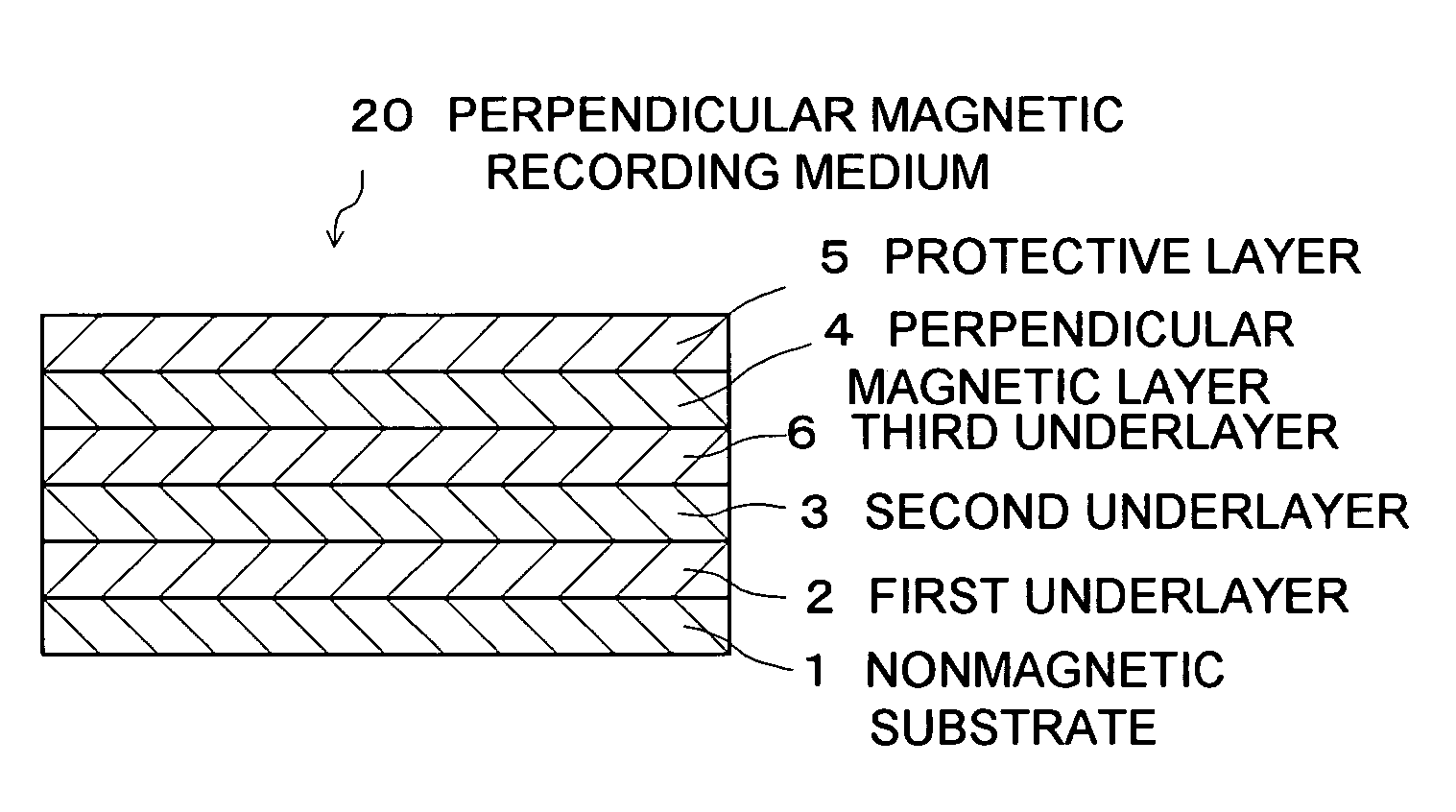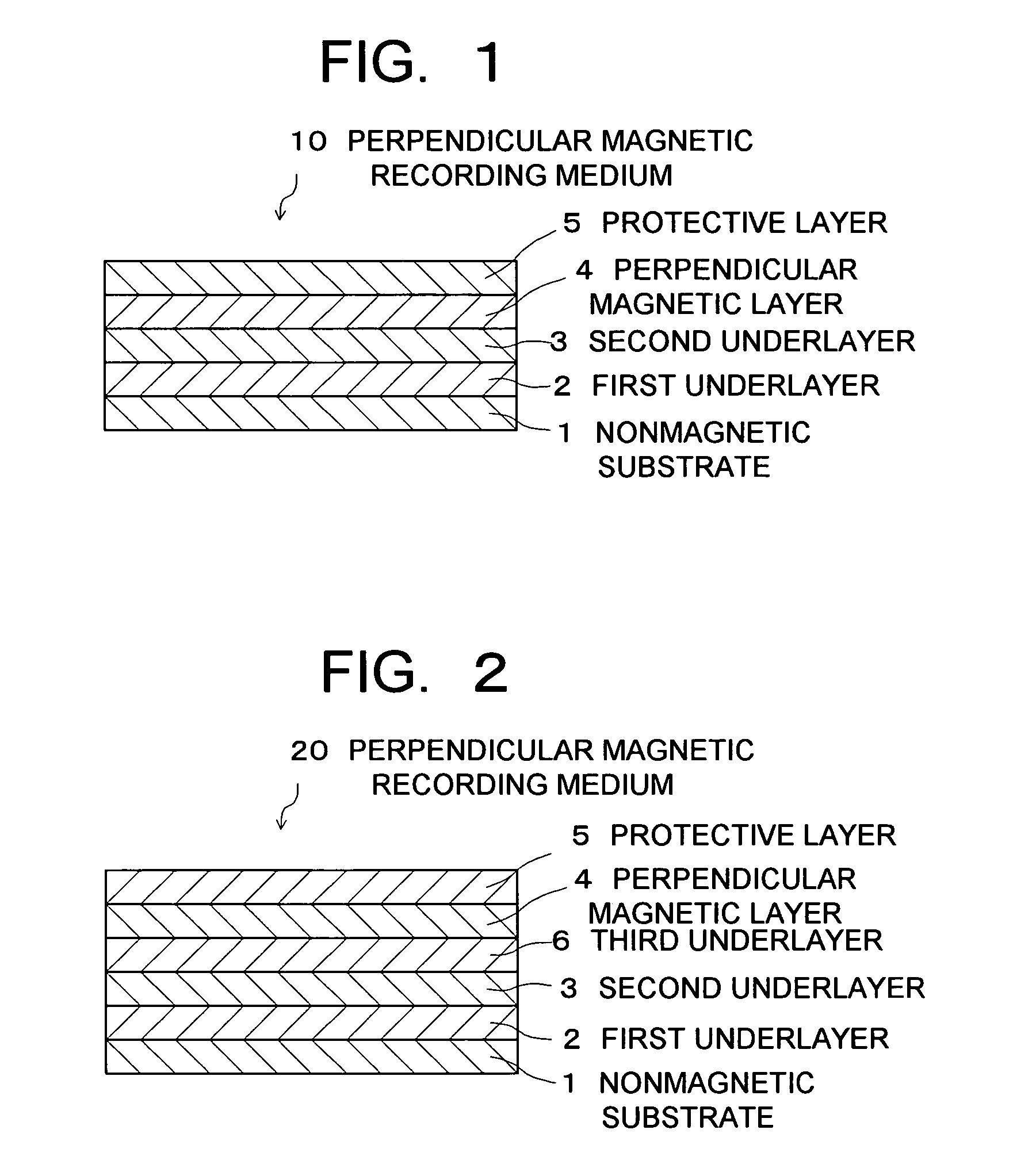Perpendicular magnetic recording medium and magnetic recording/reproducing apparatus
a technology of magnetic recording medium and perpendicular magnetic recording medium, which is applied in the direction of magnetic recording, data recording, instruments, etc., can solve the problems of increasing the noise generated by the medium, deteriorating the thermal fluctuation resistance, and difficult to achieve the current film forming technology, etc., to achieve good crystallinity and small grain distribution
- Summary
- Abstract
- Description
- Claims
- Application Information
AI Technical Summary
Benefits of technology
Problems solved by technology
Method used
Image
Examples
example 1
[0073]A nonmagnetic substrate made of crystallized glass for a 2.5-inch magnetic disk was prepared. This nonmagnetic substrate was placed in a vacuum chamber with a vacuum degree of 1×10−5 Pa, was heated to the temperature of 250° C., and was subjected to DC magnetron sputtering in an Ar atmosphere at a gas pressure of 0.6 Pa.
[0074]First, the nonmagnetic substrate was disposed to face a target, and DC500 W was discharged to the target, thereby forming a Cr layer to a thickness of 40 nm as a backing nonmagnetic layer. A CoCrPt ferromagnetic layer was formed thereon as a biasing layer to have a thickness of 25 nm. On the resultant CoCrPt ferromagnetic layer, a CoZrNb soft magnetic layer with a thickness of 200 nm was formed.
[0075]Thereafter, on the CoZrNb soft magnetic layer, a FeO-SiO2 layer as a first underlayer was formed to have a thickness of 10 nm by using a FeO-30 mol % SiO2 target and discharging 500 W.
[0076]Thereafter, the resultant workpiece was heated to 500° C. in an oxyge...
example 2
[0094]As the first underlayer 12, a CoO-30 mol % SiO2 composite target was prepared. A perpendicular magnetic recording medium was fabricated in the same manner as in the example 1 except that the above composite target was used instead of the FeO-30 mol % SiO2 composite target.
[0095]The resultant perpendicular magnetic recording medium has the same layer structure as that of the perpendicular magnetic recording medium 50 shown in FIG. 6 except that the first underlayer 12 is different.
[0096]TEM observation and image processing were conducted on the first underlayer 12 of the resultant perpendicular magnetic recording medium 50 in the same manner as in the example 1, and the grain size distribution of crystal grains of the first underlayer 12 was examined. The result showed that the first underlayer 12 was formed of crystal grains with a grain size of about 5 nm, and a standard deviation of the grain distribution was 0.8 nm or less. Further, grain boundaries with a thickness of abou...
example 3
[0106]As the first underlayer 12, MgO-40 mol % SiO2 composite targets were prepared. Perpendicular magnetic recording media were fabricated in the same manner as in the example 1 except that the MgO-40 mol % SiO2 composite targets were used instead of the FeO-30 mol % SiO2 composite target and film thickness was variously changed.
[0107]Each of the resultant perpendicular magnetic recording media has the same layer structure as that of the perpendicular magnetic recording medium 50 shown in FIG. 6 except that the first underlayer 12 is different.
[0108]On each of the various perpendicular magnetic recording media that were obtained, the grain size distribution was measured and a recording / reproducing characteristic was evaluated in the same manner as in the example 1.
[0109]FIG. 7 shows a graph representing the correlation between film thickness and SNRm and between film thickness and crystal grain size in the first underlayer of MgO-40 mol % SiO2. Curves 101, 111 are graphs representi...
PUM
| Property | Measurement | Unit |
|---|---|---|
| thickness | aaaaa | aaaaa |
| thickness | aaaaa | aaaaa |
| grain size | aaaaa | aaaaa |
Abstract
Description
Claims
Application Information
 Login to View More
Login to View More - R&D
- Intellectual Property
- Life Sciences
- Materials
- Tech Scout
- Unparalleled Data Quality
- Higher Quality Content
- 60% Fewer Hallucinations
Browse by: Latest US Patents, China's latest patents, Technical Efficacy Thesaurus, Application Domain, Technology Topic, Popular Technical Reports.
© 2025 PatSnap. All rights reserved.Legal|Privacy policy|Modern Slavery Act Transparency Statement|Sitemap|About US| Contact US: help@patsnap.com



